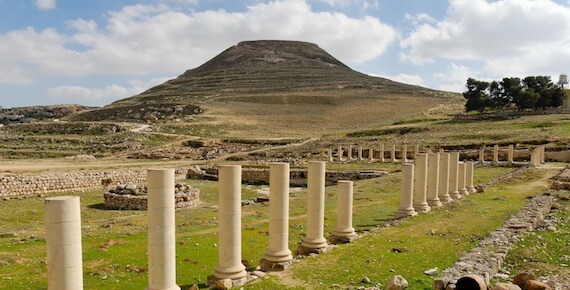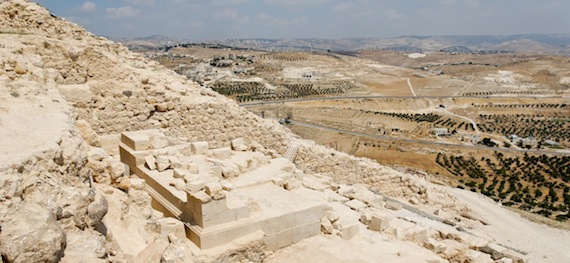Herod the Great is often remembered for the biblical account that never appears on Christmas cards. Hearing from the Magi that the “king of the Jews” was born, the paranoid Herod slew all boys under two years old in Bethlehem—a cryptic fulfillment of Jeremiah 31:15.

(Photo: The Herodium, courtesy of the Pictorial Library of Bible Lands)
Of course, Jesus’ family got word of the impending threat and escaped by night to sojourn in Egypt until Herod’s death (Matthew 2:13-18).
When I visited the Herodium in March, I couldn’t help but remember the historical irony that Herod tried to kill Jesus—but failed. Instead, Herod himself died and was buried in the Herodium overlooking the very city where the true King of the Jews was born (Micah 5:2).
The Herodium offers a lesson of great encouragement in God’s sovereignty in our lives today.
Herod’s Memorial to Himself
Appearing like a mix between a volcano and a New Mexico mesa, the Herodium dominates the landscape southeast of Bethlehem. Like Mount Tabor in the north, the Herodium has its own inimitable profile. Once you’ve seen it, you recognize it from then on.
Herod the Great named the site of the Herodium after himself as a memorial to a battle he had won there in 40 BC.
- Prior to the battle, a severe injury to his mother tempted the erratic Herod to take his own life.
- Instead, he faced the Parthians and Hasmoneans with fury and achieved a great victory.
[slideshow id=20]
(All pics courtesy of the Pictorial Library of Bible Lands)
Herod’s Posh Hiding Place
Making use of an already-existing hillside, Herod constructed a 200-foot double wall around the top of the hill. This wall towered seven stories high, and fill dirt supported the wall all around—enlarging the appearance of the hill and giving it its unique flattop appearance.
- The view atop the Herodium allows one to see the towers on the Mount of Olives to the northwest, Bethlehem immediately to the northwest, and the Judean Wilderness as it slopes eastward into the Dead Sea.
- The ruins from the Herodium boast a massive round tower, as well as three semicircular towers, a dining room, column fragments, a ritual bath, a furnace, a full-sized Roman bath, frescoes, and black and white mosaics—all typical of Herod’s opulent tastes.
- Below the hillside rests the Lower Herodium, with formal ornamental gardens, a pavilion, bathhouse, a large palace, a monumental building, and a colonnaded swimming pool.
The Herodium served as more than Herod’s summer country club. It was a place of security.
Constantly fearing rebellion from his own subjects, the paranoid Herod constructed a series of palaces and fortresses—including the Herodium—to which he could flee in a moment’s notice. His paranoia also urged him to execute any whom he feared were plotting against him—including his wife and several of his own children.
But God’s sovereignty wouldn’t allow him to kill Jesus.
Herod’s Place of Burial
Maybe because Herod contemplated taking his life in this area decades earlier, he chose the Herodium as his final resting place.

(Photo: Herod the Great’s tomb at the Herodium. Courtesy of the Pictorial Library of Bible Lands)
Josephus recounts Herod’s excruciating death at the Jericho palace. Dignitaries accompanied the funeral procession partway, and the pallbearers bore the coffin to Herodium (Antiquities 17:199; War 1:673).
- For years, skeptics doubted the accuracy of Josephus’ claim that Herod’s tomb lay at the Herodium. Years and years of searching yielded no evidence. Finally in 2007, archaeologist Ehud Netzer discovered Herod’s tomb at the Herodium.
- During the Bar-Kokhba revolt in AD 132, the Herodium served as the headquarters of the Jewish rebels who transformed the fortress’ cisterns into a system of tunnels in case of Roman attack. The patriots also modified Herod’s dining room into a synagogue similar to those found at Masada and Gamla.
- In the fifth-century, the site served as a monastery. Christian symbols still are visible in the chapel.
Herod the Great constructed the Herodium as a victory memorial. But ironically, the site stands as a monument of a paranoid king.
Even better, it’s a monument to God’s sovereignty in our lives.
Devotional Thought for the Herodium
God warned Joseph in a dream to take Jesus and Mary and flee to Egypt (see Matthew 2:1-18). In a wonderful twist of poetic irony (i.e. God’s sovereignty), the raving King Herod died and was buried in the Herodium, overlooking the birthplace of the true King of Israel.
This wasn’t the first Joseph, by the way, whom God spoke to in dreams and sent to Egypt. What Joseph the patriarch said 2000 years before Jesus was born was just as true with Jesus’ move to Egypt: “You meant evil against me, but God meant it for good in order to bring about this present result, to preserve many people alive” (Genesis 50:20).
- Caesar’s census caused Joseph and Mary to go to Bethlehem two years earlier.
- Herod’s murderous edict caused them to leave Bethlehem.
We can take encouragement that though the most powerful rulers in world make decrees and decisions that require us to move on, they only play into God’s sovereignty.
The Lord’s will for our lives is never thwarted by godless decisions. Instead He uses them for His purposes and for our good.
Tell me what you think: How has God’s sovereignty used evil for good in your life? To leave a comment, just click here.
